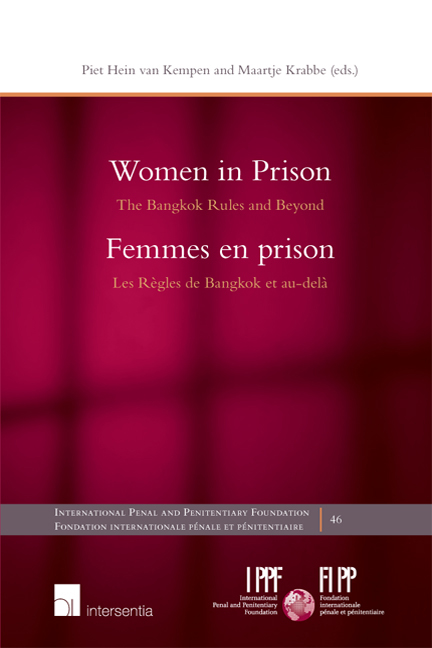Book contents
- Frontmatter
- Foreword
- Avant-propos
- Acknowledgements
- Remerciements
- Contents
- Part I Introductory Synthesis and Analyses: 1ÈRE Partie Synthèse ET Analyses Introductives
- Part II Themes: 2ÈME Partie Thèmes
- Part III National Reports: 3ÈME Partie Rapports Nationaux
- Women in prison in Argentina
- Women in prison in Australia
- Women in prison in Austria
- Women in prison in Brazil
- Women in prison in England and Wales
- Women in prison in Finland
- Femmes en prison en France
- Women in prison in Germany
- Women in prison in Greece
- Women in prison in Ireland
- Femmes en prison en Italie
- Women in prison in the Netherlands
- Women in prison in New Zealand
- Women in prison in Poland
- Women in prison in Portugal
- Women in prison in Russia
- Women in prison in South Africa
- Women in prison in Spain: their criminological and social invisibility
- Femmes en prison en Suisse: la situation des femmes prévenues et condamnées
- Women in prison in Taiwan
- Women in prison in Thailand: implementation of the UN Bangkok Rules in the Thai criminal justice system
- Femmes en prison en Turquie
- Women in prison in the USA
- Appendix The Bangkok Rules: Annexe Règles De Bangkok
- The International Penal and Penitentiary Foundation: History and Purpose
Women in prison in Australia
from Part III - National Reports: 3ÈME Partie Rapports Nationaux
Published online by Cambridge University Press: 25 September 2018
- Frontmatter
- Foreword
- Avant-propos
- Acknowledgements
- Remerciements
- Contents
- Part I Introductory Synthesis and Analyses: 1ÈRE Partie Synthèse ET Analyses Introductives
- Part II Themes: 2ÈME Partie Thèmes
- Part III National Reports: 3ÈME Partie Rapports Nationaux
- Women in prison in Argentina
- Women in prison in Australia
- Women in prison in Austria
- Women in prison in Brazil
- Women in prison in England and Wales
- Women in prison in Finland
- Femmes en prison en France
- Women in prison in Germany
- Women in prison in Greece
- Women in prison in Ireland
- Femmes en prison en Italie
- Women in prison in the Netherlands
- Women in prison in New Zealand
- Women in prison in Poland
- Women in prison in Portugal
- Women in prison in Russia
- Women in prison in South Africa
- Women in prison in Spain: their criminological and social invisibility
- Femmes en prison en Suisse: la situation des femmes prévenues et condamnées
- Women in prison in Taiwan
- Women in prison in Thailand: implementation of the UN Bangkok Rules in the Thai criminal justice system
- Femmes en prison en Turquie
- Women in prison in the USA
- Appendix The Bangkok Rules: Annexe Règles De Bangkok
- The International Penal and Penitentiary Foundation: History and Purpose
Summary
INTRODUCTION
Australia's correctional and prison services are governedby each of the eight States and Territories. There are no Commonwealth prisons or facilities in Australia, and persons who have been sentenced to a period of imprisonment from breaching Commonwealth legislation are sent to State or Territory correctional centers. There is no common legislation that applies to all of the country's prisons. Each jurisdiction enacts legislation and regulations for governance of its correctional centers that are applicable to both men and women. Nationwide there are 113 public and private prisons in Australia, with 38 detaining women. Like other countries, Australia has experienced an increase in the rate of female imprisonment greater than that of male imprisonment. The average daily number of women held in these facilities in 2013 was 2,260, comprising 7.6% of the total Australian prison population. While their proportion of the prison population has been steadily increasing, Australia's correctional centers are still, for the most part, male systems that have been (somewhat) adjusted to suit the needs of women. Australia has begun to make progress in taking a more gendered approach to female imprisonment, but still has a long way to go to properly address the specific needs of women in prison and to realize and/or adopt the Rules contained in the Bangkok Rules.
The following chapter of work provides a thorough insight into women's imprisonment throughout Australia. Section 2 will explore the international and human rights framework within which Australia operates. The most striking aspect is the lack of a central domestic human rights charter, as Australia remains the only Western democratic nation without such an instrument. Section 3 will provide statistics and analysis on Australia's approach to women in prison. It will explore the backgrounds of the women who come into contact with Australia's criminal justice system, and the various factors that may provide a useful place for authorities to consider when seeking to prevent and deter women from making that initial contact with the system. Section 4 will consider the deprivation of liberty phase, exploring the conditions under which women are held in in prison in Australia.
INTERNATIONAL AND HUMAN RIGHTS FRAMEWORK
INTERNATIONAL ORGANISATION
Australia was a founding member of the United Nations (UN). Australia held the first Presidency of the Security Council in 1946, and was a member last in 2013 and 2014.
- Type
- Chapter
- Information
- Women in PrisonThe Bangkok Rules and Beyond, pp. 205 - 250Publisher: IntersentiaPrint publication year: 2017



